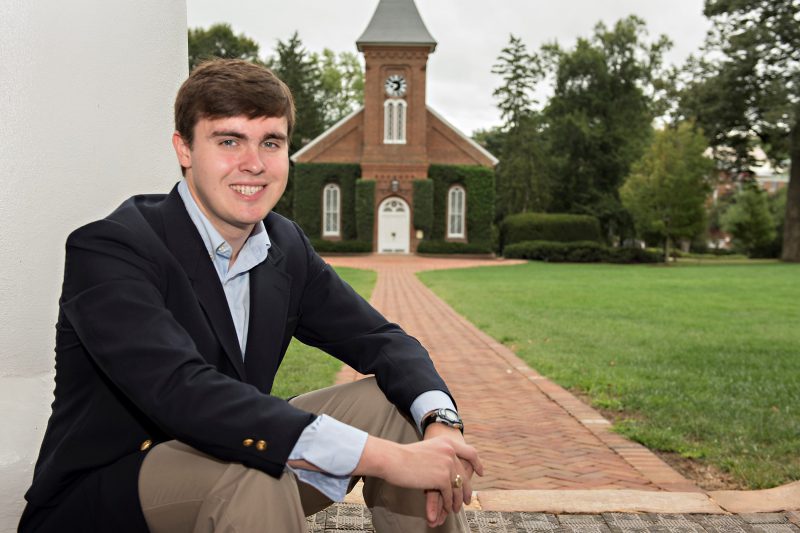Catching Waves Jamie Hayes ’17 spent two summer months in New Zealand, where he conducted research that could eventually help to improve the diagnosis of gastrointestinal ailments.
“I think it was really formative for him to work on the details and see the broad picture firsthand.”
— Prof. Jon Erickson
Washington and Lee University students are provided with plenty of opportunities for overseas travel, but Jamie Hayes ’17 never envisioned the kind of spring and summer he had in 2016.
Hayes, a physics and engineering major from Chattanooga, Tennessee, spent spring break on a tour of Ireland with the University Singers, then headed to Switzerland for a physics and engineering study-abroad course. When summer arrived, he traveled with the Outing Club to Nepal, then jetted straight from there to Auckland, New Zealand, for a nine-week summer research project at the Auckland Bioengineering Institute (ABI) at the University of Auckland.
“It was a whirlwind,” he said, “and an amazing opportunity that I got to do all these things.”
The New Zealand trip was a continuation of an ongoing research project founded in 2009 by Jonathan Erickson, associate professor of physics and engineering at Washington and Lee. For years, Erickson has partnered with fellow researchers at the ABI to create a device that can diagnose digestive ailments by measuring gastrointestinal slow waves, or electric signals transmitted by cells in the stomach. These signals relay the condition of the organ and control its function.
The ideal scenario for the equipment: A patient visits the doctor complaining of stomach pain. The doctor places electrodes on the patient’s abdomen, uses the device to measure slow waves, then analyzes the data to make a diagnosis. No surgery, no guesswork — just an easy, affordable, non-intrusive method to drastically improve care in patients with digestive ailments.
This kind of test is now possible, but systems that measure these signals are expensive and not well developed. Erickson and his fellow researchers want to develop a more reliable system that costs hundreds, not thousands, of dollars.
Hayes had worked on the project on campus during the summer of 2015 and winter term, so his trip to Auckland was a natural extension of that experience. In New Zealand, he compared an existing system called the Biosemi to the system in development, which is called the FlexiMap. Although the Biosemi provided higher-quality data than the FlexiMap, Hayes was able to determine that software-filtering techniques could greatly improve the outcome.
“It was pretty rewarding to see that the unmodified FlexiMap was only recording 45 percent of the potential signal,” Hayes said. “Professor Erickson reminded me of a simple calculation I could perform to determine that percentage. To see that by making a small hardware modification there would be such a huge signal increase, bodes extremely well for potentially replacing the Biosemi with the FlexiMap.”
Erickson joined Hayes in Auckland in August, and will stay on for sabbatical through July 2017. He has picked up where Hayes left off and is working to implement the modification. In the near future, he said, they will validate the system on pigs, with a goal of eventually doing trials on humans.
The project team has been developing this device for use with an analysis method called an electrogastrogram (EGG), which is essentially an EKG for the stomach. Since the stomach signal is much weaker than the heart’s signal, the challenge will be to develop a method that can pick up signals with electrodes placed on the surface of the skin, as opposed to directly on the stomach.
Erickson said Hayes did an excellent job folding his coursework and on-campus research at W&L into the summer project in New Zealand.
“Working at ABI this summer with an interdisciplinary team of engineers and GI physiologists provided an excellent opportunity for him to begin solving some of the technical challenges and understand the clinical potential of biomedical device development,” Erickson said. “I think it was really formative for him to work on the details and see the broad picture firsthand.”
Hayes’ trip to New Zealand was made possible by a Johnson Opportunity Grant, an Andrew W. Mellon Foundation grant, and the E.A. Morris Charitable Foundation.
Taking part in that kind of hands-on research as an undergraduate was “a dream come true,” Hayes said. Spending two months in one of the most beautiful and fascinating countries in the world wasn’t so bad, either.
“New Zealand is an amazing place,” he said. “It’s hard to put into words all the amazing parts of my experience there. There are just so many different cultures and people there, and so many different things and places to do and visit. All in all, it was incredible.”
 Jamie Hayes ’17
Jamie Hayes ’17
You must be logged in to post a comment.